Why Do My Microgreens Smell?
Key Takeaways
- The causes of odor in microgreens are overwatering, overcrowding, extreme temperatures, insufficient airflow, and high humidity.
- To prevent odor in microgreens, install an effective irrigation system, avoid overcrowding, keep humidity levels low, regulate temperature, avoid excessive chemical use, use sterile equipment and trays, and increase airflow.
- Regular monitoring and maintenance are crucial in preventing odor issues, including checking moisture levels, discarding affected microgreens, storing harvested microgreens properly, and providing adequate air circulation.
Microgreens are a popular choice for home gardeners and commercial growers alike. They are nutrient-dense, flavorful, and easy to grow. However, one common problem that many people face is the unpleasant odor that can develop in their microgreens. In this article, we will explore the reasons behind this issue and provide you with practical solutions to prevent your microgreens from smelling.
The Causes of Odor in Microgreens
The causes of odor in microgreens are most likely due to overwatering, which can lead to mold or stem rot. Other factors that can contribute to foul-smelling microgreens include overcrowding, high or low temperatures, insufficient airflow, and high humidity.
Overwatering is a common mistake that many growers make. Microgreens have delicate roots, and excessive moisture can create the perfect environment for mold and bacteria to thrive. When microgreens are overwatered, the excess moisture can lead to rotting and molding, resulting in an unpleasant smell.
Another factor that can contribute to the odor is overcrowding. When microgreens are densely packed together, water can get trapped around their stems, promoting rot and mold growth.
Extreme temperatures can also play a role in the development of odor in microgreens. High temperatures can promote the growth of mold, while low temperatures can cause the microgreens to become waterlogged and rot.
Insufficient airflow and high humidity are additional factors that can contribute to foul-smelling microgreens. Without proper ventilation, the microgreens can become damp and prone to mold and bacterial growth.
Preventing Odor in Microgreens
If you are experiencing odor issues with your microgreens, there are several steps you can take to prevent it:
- Install an effective irrigation system: Avoid overwatering by using a well-designed irrigation system that provides just the right amount of moisture for your microgreens.
- Avoid overcrowding: Give your microgreens enough space to grow. Avoid planting them too close together, as this can trap water around their stems and contribute to odor issues.
- Keep humidity levels low: Mold and rot thrive in high humidity environments. Use a dehumidifier or ensure proper ventilation to keep the humidity levels in check.
- Regulate temperature: Maintain a moderate temperature range for your microgreens, avoiding extremes that can promote mold growth or rot. Aim for a temperature between 18-24 degrees Celsius.
- Avoid excessive chemical use: Opt for clean, uncontaminated soil and avoid using excessive chemicals on your microgreens. Chemical residues can contribute to unpleasant smells.
- Use sterile equipment and trays: Before planting your microgreens, make sure your trays and equipment are clean and free from mold or bacteria. Sterilizing them can help prevent the growth of odor-causing microorganisms.
- Increase airflow: Improve air circulation in your growing area by using fans or ensuring proper ventilation. This can help prevent the buildup of moisture and reduce the risk of odors.
Monitoring and Maintenance
Regular monitoring and maintenance are crucial in preventing odor issues in your microgreens. Here are some additional tips:
- Check the moisture levels in the soil regularly and avoid overwatering. Microgreens prefer slightly moist soil, but excessive moisture can lead to odor problems.
- Discard any microgreens that show signs of molding or rotting. Removing affected plants will prevent the spread of odor-causing microorganisms.
- Store harvested microgreens in a sealed container in the refrigerator for up to three days. This will help maintain their freshness and prevent the development of odor.
- Provide adequate air circulation, especially in indoor growing environments. This can be achieved by using fans or ensuring proper ventilation.
By following these preventive measures and practicing regular monitoring and maintenance, you can enjoy fresh and fragrant microgreens without any unpleasant odors.
Related Websites:
FAQs:
Q: Why do microgreens smell?
Microgreens can emit a smell due to various factors. Environmental conditions, such as temperature and humidity levels, along with proper air circulation, play a role. The choice of growing medium and water quality can also impact the odor. Additionally, seed quality and storage practices affect the likelihood of unpleasant smells.
Q: How do environmental conditions affect microgreen smell?
Environmental conditions, such as temperature and humidity levels, can influence microbial growth, which can lead to odor in microgreens. Proper air circulation and ventilation are crucial in preventing stagnation and the buildup of unpleasant smells.
Q: Can seed quality impact microgreen smell?
Yes, using high-quality seeds reduces the likelihood of unpleasant smells in microgreens. Proper seed storage to prevent moisture and fungal contamination is also important in maintaining the desired aroma.
Q: How can I prevent and mitigate microgreen odor?
To prevent and mitigate microgreen odor, practice proper hygiene and sanitation by cleaning and sterilizing growing trays, equipment, and surfaces. Maintain optimal growing conditions, including suitable temperature, humidity, air circulation, and ventilation. Harvest microgreens at the appropriate stage and store them in a cool and dry environment.
Q: What should I do if my microgreens smell strongly?
If your microgreens have a strong smell, it is recommended to evaluate and adjust the environmental conditions, growing medium, and water quality. Check for signs of mold or bacterial growth and ensure proper hygiene and sanitation. Harvest microgreens at the appropriate stage and store them in optimal conditions to minimize any unpleasant odors.






